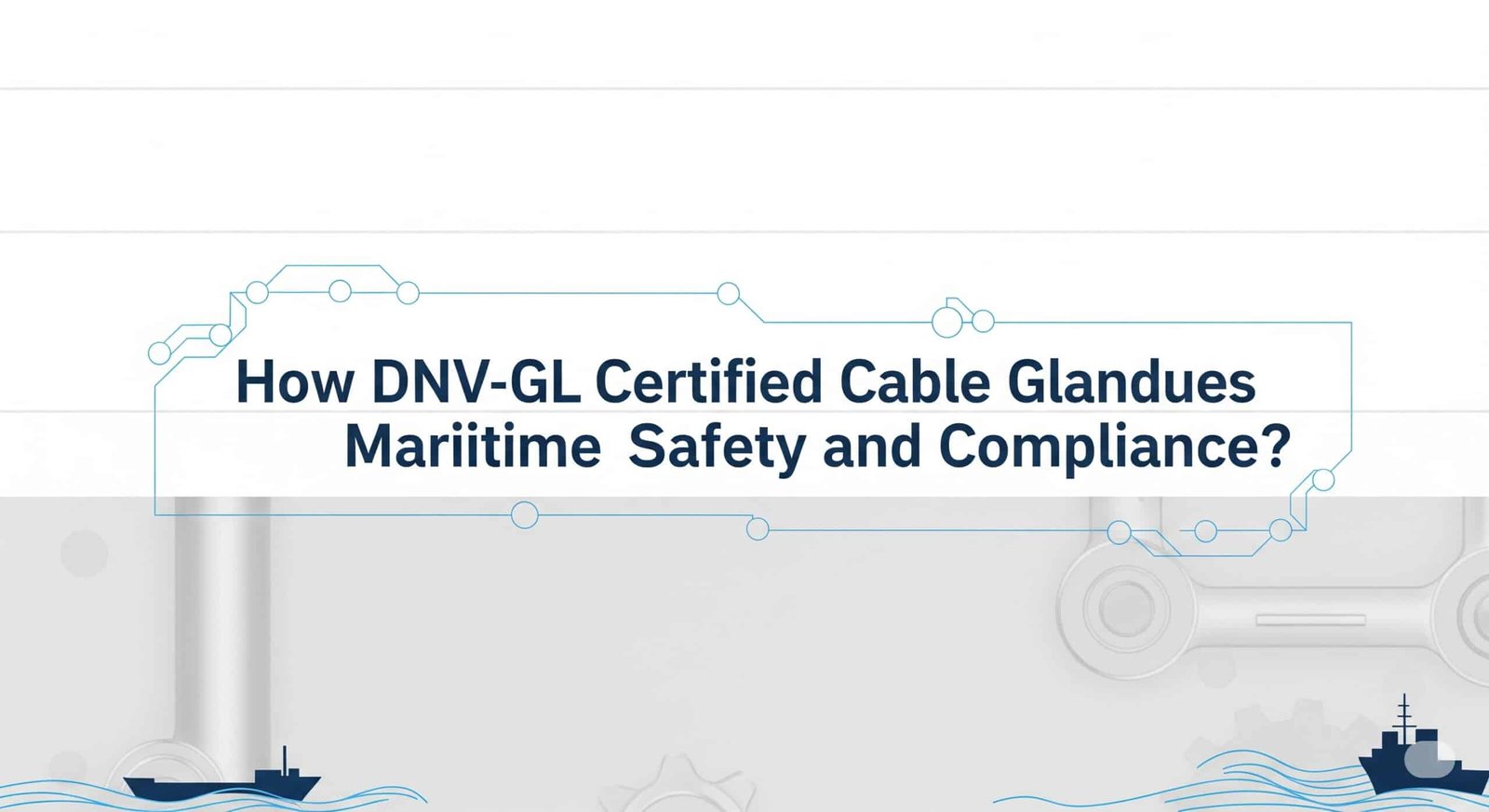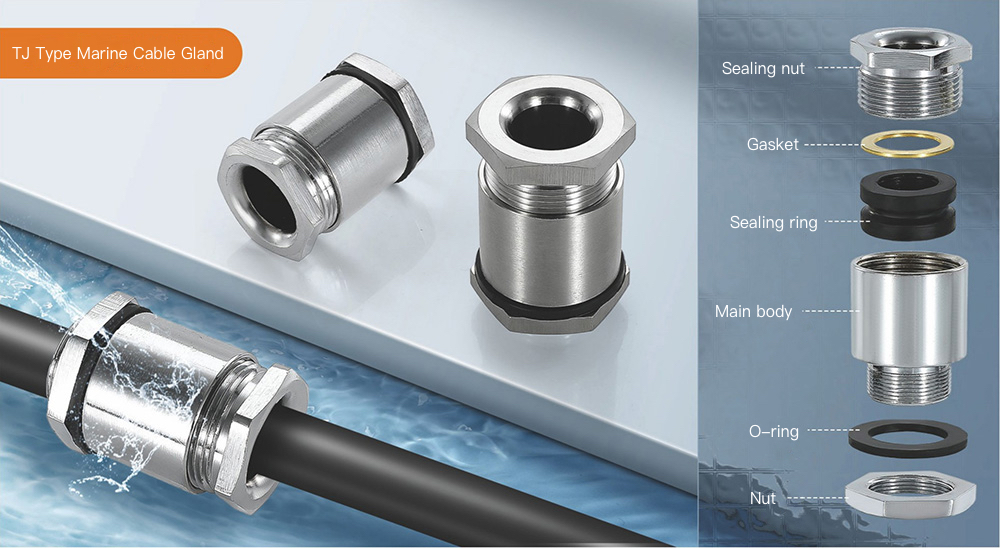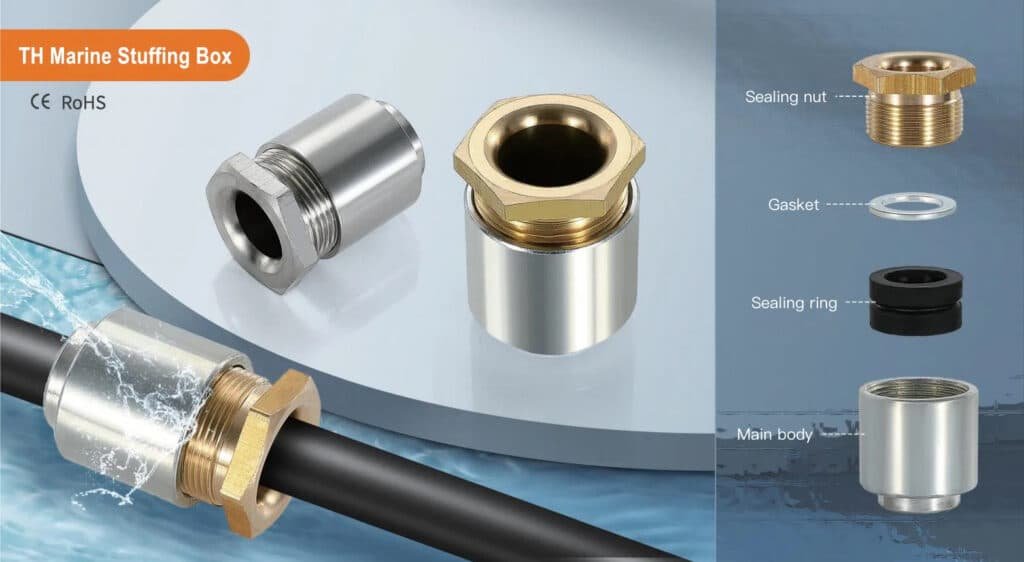Building offshore platforms or marine vessels? One certification failure can sink your entire project timeline and budget.
DNV-GL certification ensures your cable glands meet the world’s most stringent maritime safety standards – without it, your equipment cannot be installed on commercial vessels, offshore platforms, or marine renewable energy projects.
Last month, I received an urgent call from Captain Erik, a project manager for a North Sea wind farm installation. His previous supplier’s cable glands failed DNV-GL inspection just days before installation. The delay cost €200,000 and nearly jeopardized the entire seasonal weather window. 😉
Table of Contents
- Why DNV-GL Standards Are Critical for Maritime Applications?
- Which DNV-GL Requirements Apply to Your Cable Gland Selection?
- How Do You Ensure Proper DNV-GL Certification and Documentation?
- What Are the Long-Term Benefits and Cost Implications?
Why DNV-GL Standards Are Critical for Maritime Applications?
Maritime environments demand the highest safety standards – there’s no room for equipment failure at sea.
DNV-GL (Det Norske Veritas – Germanischer Lloyd)1 sets global standards for maritime safety, covering everything from material selection to environmental testing, ensuring cable glands can withstand extreme marine conditions for decades.
The Maritime Safety Imperative
Unlike land-based installations where equipment failure might cause downtime, maritime failures can result in:
- Life-threatening emergencies in harsh sea conditions
- Environmental disasters from oil spills or chemical releases
- Multi-million dollar losses from vessel or platform damage
- Regulatory violations leading to operational shutdowns
DNV-GL standards address these risks through comprehensive testing and certification protocols that go far beyond typical industrial requirements.
DNV-GL’s Global Authority
DNV-GL operates as the world’s leading maritime classification society2 with authority to:
- Certify vessel designs and equipment for international waters
- Conduct statutory surveys required by international maritime law
- Issue certificates recognized by port authorities worldwide
- Maintain ongoing oversight through periodic inspections
Key Statistics:
- Classifies 21% of the world’s merchant fleet
- Certifies 65% of offshore units globally
- Operates in 100+ countries
- Maintains 350+ offices worldwide
Maritime vs. Industrial Standards Comparison
| Aspect | DNV-GL Maritime | Industrial Standards |
|---|---|---|
| Environmental Testing | Salt spray, UV, extreme temperatures | Standard environmental conditions |
| Vibration Requirements | Ship/platform dynamic loading | Static or minimal vibration |
| Corrosion Resistance | 25+ year marine exposure | 5-10 year typical environments |
| Fire Safety | IMO SOLAS compliance3 | Local fire codes |
| Documentation | Lifetime traceability | Standard quality records |
Real-World Consequences
Captain Erik’s wind farm project illustrates why DNV-GL certification matters. His original supplier provided “marine-grade” cable glands that looked identical to DNV-GL certified products but lacked proper certification.
The inspection revealed:
- Missing DNV-GL type approval certificates
- Inadequate corrosion testing documentation
- Non-compliant marking and labeling
- Insufficient quality system oversight
Project Impact:
- 3-week installation delay
- €200,000 in additional costs
- Risk of missing optimal weather window
- Potential regulatory penalties
Resolution:
We provided emergency DNV-GL certified replacements with complete documentation packages, allowing the project to proceed within the critical installation period.
Which DNV-GL Requirements Apply to Your Cable Gland Selection?
Selecting the wrong DNV-GL standard or missing critical requirements can invalidate your entire electrical installation.
Cable glands for maritime applications must meet DNV-GL Rules for Ships Part 4 Chapter 8 (Electrical Installations) and specific environmental standards including DNV-GL-CG-03394 for marine equipment certification.
Core DNV-GL Requirements for Cable Glands
DNV-GL Rules for Ships – Part 4, Chapter 8:
This fundamental standard covers electrical installations aboard vessels and includes specific requirements for:
- Cable penetration systems through bulkheads and decks
- Environmental sealing for weather-tight and watertight applications
- Fire-stopping properties to prevent fire spread between compartments
- Mechanical strength to withstand ship movement and vibration
Material Requirements:
- Corrosion-resistant materials suitable for marine environments
- Non-magnetic materials for compass-safe installations
- Fire-retardant properties meeting IMO requirements
- UV-resistant materials for deck and superstructure applications
Environmental Testing Standards
DNV-GL-CG-0339: Certification of Marine Equipment
This certification guideline establishes testing protocols for marine equipment including:
Salt Spray Testing:
- Extended exposure periods (1000+ hours)
- Accelerated corrosion simulation
- Performance verification after exposure
- Visual and functional assessment
Temperature Cycling:
- Arctic to tropical temperature ranges (-40°C to +70°C)
- Thermal shock resistance
- Expansion/contraction stress testing
- Seal integrity maintenance
Vibration and Shock Testing:
- Ship engine vibration simulation
- Wave impact shock testing
- Resonance frequency identification
- Fatigue resistance verification
Application-Specific Requirements
Merchant Vessels:
- DNV-GL Class notation requirements
- Flag state regulation compliance
- Port state control5 readiness
- ISM Code documentation
Offshore Platforms:
- Enhanced environmental testing
- Explosion-proof requirements (if applicable)
- Extended service life validation (25+ years)
- Emergency response system integration
Renewable Energy Installations:
- Wind turbine foundation requirements
- Subsea cable transition systems
- High-voltage application standards
- Grid connection compliance
Naval and Military Applications:
- MIL-STD compliance integration
- Shock hardening requirements
- EMI/EMC performance standards
- Security and tamper resistance
Certification Categories and Scope
Type Approval:
Complete product certification for specific applications including:
- Design evaluation and testing
- Manufacturing quality system assessment
- Ongoing production oversight
- Certificate maintenance and updates
Component Certification:
Individual component approval for integration into larger systems:
- Material property verification
- Interface compatibility confirmation
- Performance parameter validation
- Integration guidance documentation
At Bepto, our DNV-GL certified cable glands meet the full scope of maritime requirements with certifications covering:
- Merchant vessel applications
- Offshore platform installations
- Renewable energy systems
- Naval and coast guard vessels
How Do You Ensure Proper DNV-GL Certification and Documentation?
Incomplete documentation or improper certification can halt your project during critical installation phases.
Successful DNV-GL compliance requires verified type approval certificates, complete technical documentation packages, proper product marking, and ongoing surveillance records – all maintained throughout the product lifecycle.
Essential Documentation Requirements
Type Approval Certificate Package:
Every DNV-GL certified cable gland must include:
- Original type approval certificate with unique identification number
- Technical specification sheets detailing performance parameters
- Test reports from accredited laboratories
- Installation instructions with DNV-GL compliance guidance
- Material certificates for all components
- Quality system documentation from certified manufacturers
Critical Certificate Elements:
- DNV-GL logo and authorized signature
- Specific product model numbers and variants
- Application scope and limitations
- Valid certificate dates and renewal requirements
- Authorized representative contact information
Verification Process
Certificate Authentication:
- DNV-GL Database Check: Verify certificate numbers through official DNV-GL systems
- Issuing Office Confirmation: Contact the issuing DNV-GL office directly
- Manufacturer Verification: Confirm authorized manufacturing locations
- Scope Validation: Ensure certificate covers your specific application
Documentation Review Checklist:
- Complete technical drawings with dimensions and materials
- Environmental test reports with actual test data
- Installation procedures with torque specifications
- Maintenance requirements and inspection intervals
- Spare parts lists with DNV-GL certified components
Common Certification Pitfalls
From my experience with Captain Erik and other maritime projects, these issues cause the most problems:
Incomplete Certification Scope:
Many suppliers provide certificates that don’t cover the specific application or environmental conditions required for your project.
Expired or Suspended Certificates:
DNV-GL certificates require ongoing surveillance and can be suspended for non-compliance with manufacturing requirements.
Counterfeit Documentation:
Unfortunately, fake DNV-GL certificates exist in the market. Always verify through official channels.
Missing Installation Documentation:
Even certified products can fail inspection if installation procedures don’t meet DNV-GL requirements.
Quality System Requirements
Manufacturing Oversight:
DNV-GL requires certified manufacturers to maintain:
- ISO 9001 quality management systems
- Regular factory inspections
- Production testing protocols
- Non-conformance reporting systems
- Continuous improvement processes
Supply Chain Control:
- Raw material traceability
- Supplier qualification programs
- Incoming inspection procedures
- Storage and handling protocols
- Shipping and packaging standards
Installation and Commissioning Support
Pre-Installation Services:
- Technical review of installation plans
- Compatibility verification with vessel systems
- Installation procedure development
- Inspector training and certification
Commissioning Documentation:
- Installation records with photos
- Testing and verification reports
- As-built drawings and documentation
- Maintenance schedule establishment
- Warranty registration and activation
At Bepto, we provide comprehensive DNV-GL compliance support including:
- Complete documentation packages
- Technical installation support
- Inspector training programs
- Ongoing maintenance guidance
- Certificate renewal management
What Are the Long-Term Benefits and Cost Implications?
Understanding the full lifecycle value helps justify the premium investment in DNV-GL certified equipment.
DNV-GL certification typically adds 20-40% to initial cable gland costs but provides 25+ year service life, reduced maintenance requirements, insurance benefits, and global market access worth millions in project opportunities.
Comprehensive Cost Analysis
Initial Investment Premium:
DNV-GL certified cable glands typically cost more than standard industrial products:
- Material upgrades: Marine-grade alloys and sealing compounds
- Enhanced testing: Extended environmental and performance validation
- Certification fees: DNV-GL approval and ongoing surveillance costs
- Documentation: Comprehensive technical file preparation
- Quality systems: Manufacturing oversight and control
Typical Cost Premiums:
- Standard applications: 20-30% above industrial grade
- Harsh environment applications: 30-50% premium
- Specialized offshore applications: 50-100+ % premium
Long-Term Value Benefits
Extended Service Life:
DNV-GL certified products are designed for 25+ year service life in marine environments compared to 5-10 years for standard industrial products.
Reduced Maintenance Costs:
- Lower failure rates reduce emergency repairs
- Predictable maintenance schedules
- Reduced spare parts inventory requirements
- Minimized vessel downtime
Insurance and Liability Benefits:
- Lower insurance premiums for certified equipment
- Reduced liability exposure for operators
- Protection against regulatory penalties
- Enhanced safety record maintenance
Market Access Opportunities
Global Project Eligibility:
DNV-GL certification opens access to international maritime projects worth billions annually:
Offshore Wind Market: $50+ billion annual investment globally
Oil & Gas Platforms: $30+ billion in new developments
Merchant Shipping: $150+ billion vessel construction market
Naval Projects: $25+ billion in government contracts
Regional Market Advantages:
North Sea Operations: DNV-GL certification is virtually mandatory for Norwegian and UK offshore projects.
Asian Shipbuilding: Major shipyards in South Korea, China, and Japan require DNV-GL certified components for export vessels.
Middle East Energy: Qatar, UAE, and Saudi Arabia offshore projects specify DNV-GL standards.
Americas Offshore: US Gulf of Mexico and Canadian Arctic projects increasingly require DNV-GL certification.
ROI Case Study Analysis
Captain Erik’s Wind Farm Project:
- Initial investment: €45,000 for DNV-GL certified cable glands
- Alternative cost: €32,000 for non-certified products
- Premium paid: €13,000 (29% increase)
Value Realized:
- Project completion: On-time delivery worth €2.5 million bonus
- Insurance savings: €8,000 annual premium reduction
- Maintenance reduction: €15,000 over 5 years
- Regulatory compliance: Avoided potential €100,000+ penalties
Net ROI: 850%+ over project lifecycle
Competitive Advantages
Supplier Differentiation:
DNV-GL certification positions suppliers as premium maritime specialists rather than commodity providers.
Customer Confidence:
Certified products reduce customer technical risk and simplify procurement decisions.
Long-term Partnerships:
Maritime customers value suppliers who understand and meet their stringent requirements consistently.
Market Premium Pricing:
DNV-GL certified products command higher prices and better margins throughout their lifecycle.
Conclusion
DNV-GL certification transforms cable glands from commodity components into critical maritime safety systems – the investment delivers exceptional long-term value and market access.
FAQs About DNV-GL Certification for Cable Glands
Q: How long does DNV-GL certification take for cable glands?
A: Typical timeline is 6-12 months from application to certificate issuance, depending on product complexity and testing requirements. Marine applications require more extensive environmental testing than standard industrial products.
Q: Can I use DNV-GL certified cable glands for land-based applications?
A: Yes, DNV-GL certified products exceed most industrial standards and can be used for land-based applications. However, the premium cost may not be justified unless the application requires marine-grade performance.
Q: What’s the difference between DNV-GL type approval and component certification?
A: Type approval covers complete, ready-to-install products with full application scope. Component certification covers individual parts intended for integration into larger certified systems.
Q: Do I need separate certifications for different vessel types?
A: A single DNV-GL type approval typically covers multiple vessel applications, but specific vessel classes or flag states may have additional requirements. Always verify scope with your DNV-GL surveyor.
Q: What happens if DNV-GL certification expires or is suspended?
A: Expired or suspended certifications immediately prohibit new installations and may require replacement of existing equipment during vessel surveys. Maintaining ongoing compliance through manufacturer surveillance is critical for continuous certification validity.
-
Visit the official website of DNV to learn about their role in maritime classification and global safety standards. ↩
-
Understand the role and function of maritime classification societies in ensuring marine safety and environmental protection. ↩
-
Learn about the International Convention for the Safety of Life at Sea (SOLAS), the most important maritime safety treaty. ↩
-
Explore the specific DNV certification guideline for environmental testing and certification of marine equipment. ↩
-
Discover how Port State Control is used by national authorities to inspect foreign ships and enforce international regulations. ↩




